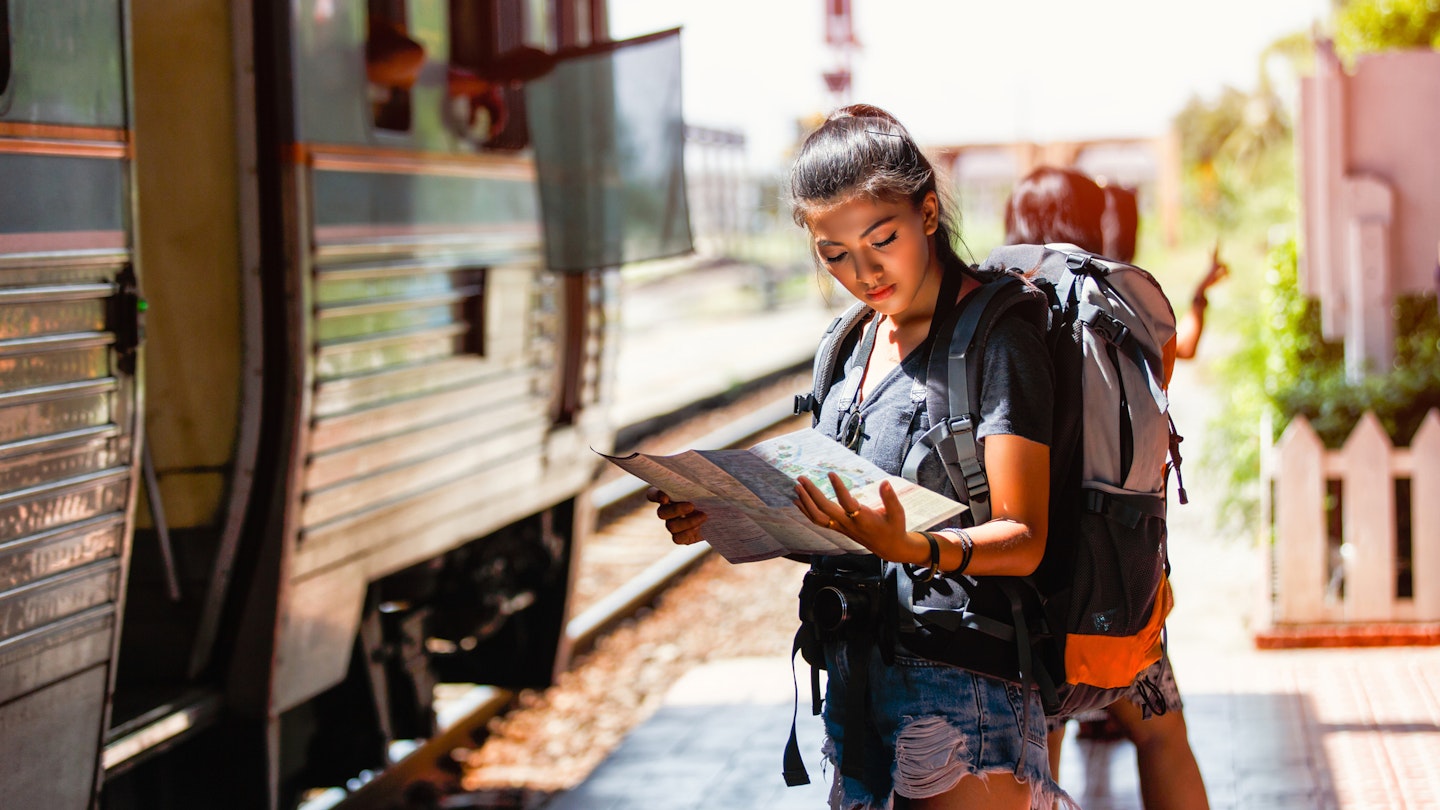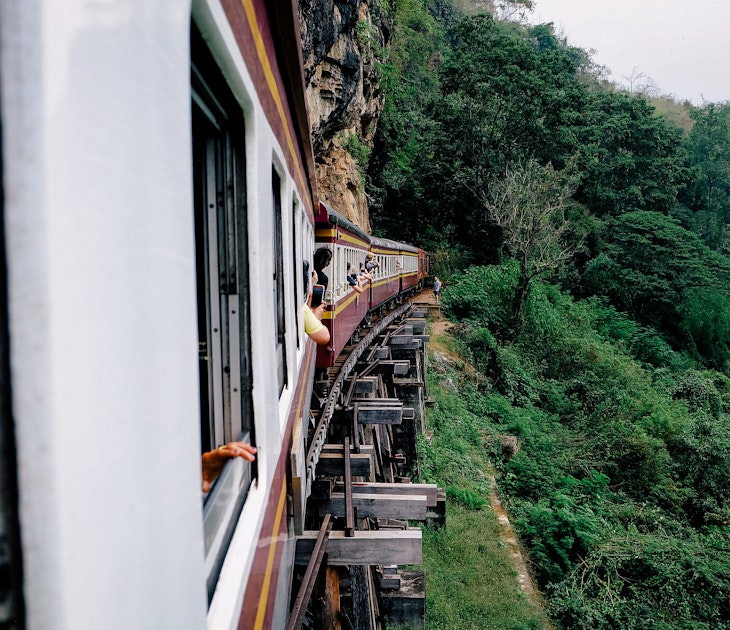Look at Thailand on a map – the country resembles an elephant's head. Stretching for more than 1000 miles (1610km) from Chiang Rai in the north (our Babar's right ear) to Narathiwat in the south (the trunk's end), there's plenty of jungle, road and shoreline for travelers to cover. Fortunately, the country's excellent, integrated transport system makes it easy to get around.
From quick, convenient flights to affordable train rides and comfortable overnight buses, here's how to make getting around Thailand an utter breeze.
Choose 3, 4, 5, 6 or 7 top Bangkok attractions and save up to 50% with Go City. Experience the city at King Power Mahanakhon Skywalk, tour Damnoen Saduak floating market, or enjoy a delicious meal on a dinner cruise - the choice is yours!
A plane will get you there quickly
Fast, affordable and pretty reliable (barring any inclement weather), a plane is often the best way to travel in Thailand. All the major tourist destinations have an airport, including Bangkok, Chiang Mai, Ko Samui, Phuket and Krabi.
For many travelers – particularly those following the popular itinerary of Bangkok, north to Chiang Mai, and then south to the islands – traveling by plane is most economical, with flights ranging from $50-$200 depending on the destination. Especially if you have limited time in Thailand. The major domestic operators are Bangkok Airways, Thai Smile, Nok Air, Thai Airways and AirAsia.
Tips for booking an internal flight in Thailand
- Budget airlines like Nok Air and AirAsia, with flights starting around $25 one-way, are sticklers when it comes to luggage. If you’re checking bags, make sure they’re under the airline’s weight requirement.
- Alternatively, pay for additional luggage ahead of your flight. This typically needs to be at least four hours ahead of check-in if you want to avoid any excess fees at the counter.
- Note that carry-on luggage is usually weighed. Anything over 7kg will be charged.

Train travel is good value in Thailand
Extensive, integrated and a great experience to boot, traveling around Thailand by train is good value for money and it also gives travelers a chance to easily get to lesser-visited parts of the country.
Get to know the different train types and classes
Thailand has four types of trains: Ordinary (ORD), Rapid (RAP), Express (EXP) and Special Express (SP EXP). Train types usually depend on both route and budget.
- Ordinary trains are the slowest with mostly third-class seating.
- Rapid trains have second-class and third-class options and stop less frequently.
- Express trains have first- to third-class seating with air-conditioned and non-air-conditioned options available.
- Special Express trains do not have third-class seating and are the fastest routes, stopping only at main stations.
First-class:
- Available on Overnight Express and Special Express trains only, first-class tickets include an air-conditioned cabin, two twin beds, a private bathroom and a lockable door.
- These are ideal for couples or a family looking for privacy.
- Book several days in advance, especially in peak season (November to March).
Second-class:
- The most popular option and available as seats or sleepers depending on the route.
- Can choose between a more expensive air-conditioned cabin or one with a fan.
- Great for solo female travelers, as there are women-only sleepers available on some trains.
Third-class:
- Recommended for short distances.
- No frills wooden seats with no air-conditioning.
- A good option for those on a tight budget.
- Great for slow scenic travel and trying local Thai snacks sold onboard.

Bus travel is a good option for travelers on a budget
Thailand buses are ideal for budget travel between destinations. Often faster and cleaner than a train, you can get to any province in Thailand directly by bus. There are a wide variety of bus routes in Thailand, from smaller villages to bigger cities offering the most flexibility when traveling the country.
As with most transport in Thailand, there are different levels of luxury. VIP and first-class buses are highly recommended for overnight journeys as they have plenty of room to recline and a toilet on the bus. Some even have small TV screens on the seatbacks. It’s a good idea to book these seats at least a day in advance.
Second-class is the cheapest option, but air-conditioning can be hit and miss, and Thai music or movies may be on full blast. So if your trip is just a few hours, consider second-class travel (and bring some headphones).
While Thailand bus travel can be plush, it does come with some caveats. Drivers can occasionally be erratic and road accidents are not uncommon.
Motorbikes are plentiful but you should have a license
Travelers must have a motorbike license in their home country and an international driver’s license or a motorcycle license in Thailand to legally drive a motorbike. With around 20,000 people dying in motor accidents per year, Thailand has the deadliest roads in Southeast Asia.
Not only could you be pulled over and fined by the police for breaking the law, but if you were involved in a traffic accident, your travel insurance would not cover the cost of hospitalization or care.

Tuk-tuks are a fun way to travel in Thai cities
These three-wheeled open-air vehicles known as tuk-tuks are a fun way to get around Thai cities (just be sure to avoid rush hour traffic when the fumes are at their very worst). It’s customary to haggle with the driver before you get in as the price they quote will always be high (costs range from $2–$15 depending on the length of the ride and how good you are at negotiating). Also, be wary of drivers who take you on detours to their “friend's shop.” This is a common scam for drivers who get kickbacks from store owners to drive tourists to their businesses.
To avoid this hassle, download the Grab app (Asia’s Uber) and select the tuk-tuk option if available. In Chiang Mai, these tuk-tuks will likely be electric as part of a sustainable initiative.
There are efficient Metro and Skytrain services in Bangkok
Although several Thai cities have plans for urban rail systems, Bangkok is currently the only city with one already in use. The Metro (MRT) and Skytrain (BTS) are the best options for reaching the major sites. Operating from 5:30am to midnight, depending on the train route, it’s more affordable and faster than a bus, taxi or tuk-tuk (although not as fun) with fares from 16B to 42B.
Passes are available for purchase in the train station, including a one-day unlimited pass for 140B with Skytrain. The Metro also has a variety of multi-trip pass options.
Ferries and boats can get you out to the islands
One of Thailand’s main draws is its pristine beaches and emerald lagoons. To reach many of these islands from the airport, you’ll need to hop on a ferry. Hotels can usually book tickets, but it’s also easily done online. Alternatively, take a taxi to the terminal and buy directly from the ticket booth.
There's not a lot of accessible transportation in Thailand
Buses and trains don’t typically have facilities for disabled passengers in Thailand. Bangkok is the only real destination where there are provisions in place but only five of the SkyTrain stations have an elevator. The Metro is more accessible as all stations have an elevator and there are locks for wheelchairs.
Download Lonely Planet's Accessible Travel guide for free.














